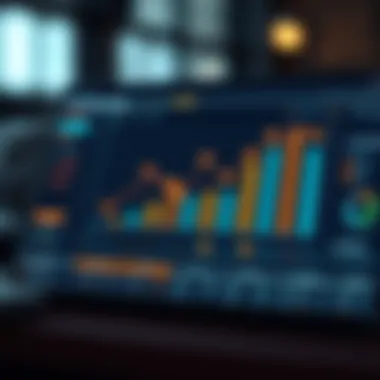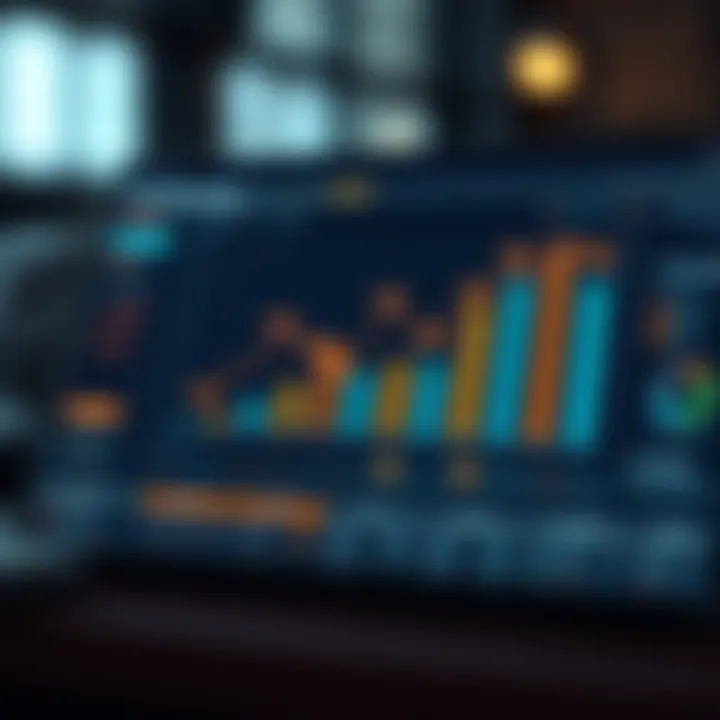Understanding PPC Advertising: A Comprehensive Overview


Intro
In the ever-evolving digital landscape, the importance of understanding advertising dynamics cannot be overstated. PPC, or pay-per-click advertising, shines brightly in this arena, proving itself as an effective way for businesses to connect with potential customers. For both budding entrepreneurs and established firms, grasping the intricacies of PPC can make a world of difference.
Imagine flinging a net into the ocean; if you don't know where the fish are, you'll come up empty. Likewise, without a strong PPC strategy, your marketing dollars might get lost. This comprehensive overview aims to unpack the essential components of PPC advertising, shedding light on its terminologies, platforms, benefits, and optimization techniques that can lead to maximizing your return on investment.
Understanding PPC isn't just for the tech-savvy—it’s crucial for anyone looking to navigate the complexities of online marketing effectively. Whether you are a novice or have some experience under your belt, this guide serves to enhance your knowledge and empower your decision-making in the digital space.
Defining PPC Advertising
Defining Pay-Per-Click (PPC) advertising is particularly crucial in the realm of digital marketing as it provides the foundational understanding needed for businesses to leverage paid search effectively. As the online market grows, the ability to stand out amidst the digital noise becomes paramount. Businesses need not just any visibility, but targeted visibility that resonates with the potential customers they wish to reach. In this context, PPC serves as a vital mechanism that allows advertisers to secure prime spots in search engine results, thereby channeling traffic directly to their products or services.
The Concept of Pay-Per-Click
The concept of Pay-Per-Click is straightforward yet powerful. In essence, it involves advertisers paying a fee each time their advertisement is clicked. This model shifts the focus from mere impressions – the number of times an ad is viewed – to actual engagement, where advertisers only incur costs when users express interest by clicking through to their websites. From a strategic perspective, this makes PPC a valuable option, particularly since it helps businesses maximize their advertising spend by ensuring they’re paying for tangible interactions rather than just passive views.
Consider this:
- Advertisers have the opportunity to fine-tune their ads using keyword targeting, which can help attract users actively searching for related products or services.
- Campaigns can be adjusted rapidly based on performance metrics, allowing for immediate optimization based on market demands and user behavior.
How PPC Works
PPC operates on online auction systems. Businesses enter bids for specific keywords that they believe their potential customers will use during searches. When a user types a query containing these keywords, search engines run an auction to determine which ads will appear and in what order. Factors like the bid amount and the quality of the ad, determined by the click-through rate, influence this.
- Bid Management: Advertisers have the flexibility to manage their bids, adjusting them based on campaign performance and competition.
- Ad Rank: This determines how prominently an ad is displayed, which is calculated by multiplying the max bid by a quality score assigned to the ad.
PPC is not just about high bids or visibility but requires careful orchestration of various elements, including compelling ad copy, keyword relevance, and effective landing pages. This blend is essential to optimize not just clicks but conversions, transforming website visitors into customers.
"If you’re not using PPC, you’re leaving money on the table, as it offers a fast track to reach the audience that is already in the market for your products."
By grasping the nuances of PPC advertising, businesses can reap the benefits of immediate visibility and precise targeting, ensuring that their marketing strategies are robust enough to compete in today’s digital landscape.
The Elements of PPC Advertising
When discussing Pay-Per-Click (PPC) advertising, it's crucial to break down the specific elements that drive success in campaigns. Each component, from keywords to landing pages, plays an integral role in shaping the outcome of your advertising efforts. Understanding these elements provides a solid foundation for optimizing your strategy, maximizing budget efficiency, and striving for higher ROI.
Keywords and Their Role
Keywords are like the building blocks of PPC campaigns. They're the terms or phrases that potential customers type into search engines when looking for products or services. Without the right keywords, your ads might end up in front of the wrong audience, which is like throwing a dart blindfolded and hoping for a bullseye.
To choose effective keywords, think about your target audience. What questions are they asking? What problems are they trying to solve? Tools like Google's Keyword Planner or SEMrush can help you discover relevant keywords with great search volumes. Add both broad and specific terms to your strategy; this gives your campaign a wider net while still capturing highly relevant traffic.
Engaging with long-tail keywords—phrases that are longer and more specific—can be a game changer. While they might not have the highest search volume, they attract serious buyers. After all, someone searching for "affordable running shoes for flat feet" is usually further along in their buying journey than just someone looking for "shoes."
Ad Copy and Creative Design
The ad copy is your chance to convince potential customers to click through. It should be a quirky blend of information and persuasion wrapped in a concise message that aligns well with your keywords. A catchy headline is essential because that’s what grabs attention first. Something like, "Transform Your Joints with Our Cushioned Run Shoes!" not only addresses a problem but draws in curiosity.
Don’t forget to have a clear call to action (CTA) in your ads. Phrases like "Shop Now!" or "Free Shipping on First Orders!" guide users on what to do next. They provide direction and can significantly increase your click-through rate (CTR).
Visuals matter too. Poorly designed ads can turn people away faster than a fire alarm in a quiet theater. Using high-quality images or videos that reflect the style and value your brand represents can also create a visual connection with your audience. Test different designs and wording to see which resonates best through A/B testing—this informs you on both the design and copy front, optimizing your clicks.
Landing Pages: The Essential Component
Now, let’s talk about landing pages. They are the destination for all those clicks. Think of landing pages as the storefront for your online ad. If they are welcoming, easy to navigate, and clearly state the benefits of the product or service, you’re likely to seal the deal. A poorly designed landing page can hinder conversions even if your ad copy was fantastic.
Every landing page should align seamlessly with the ad that brought the user there. If your ad promised free shipping, then your landing page better have the same offer front and center. Here’s a list of must-have components for an effective landing page:
- Headlines that hook: Make sure it mirrors the ad message
- Clear descriptions: Tell visitors the value of what they’re getting upfront.
- Minimal distractions: Keep it simple. Too many options can create decision fatigue.
- Trust signals: Customer reviews or testimonials can build credibility.
- Easy navigation and fast load times: If it takes too long to get to information, you could lose them before they get a chance to convert.
"If your landing pages are not optimized, all your PPC efforts might as well go down the drain."
Benefits of PPC Advertising
PPC advertising comes with a host of benefits that make it an appealing option for businesses looking to expand their online presence. Unlike traditional forms of marketing, PPC provides a clear roadmap for how to reach potential customers effectively and efficiently. The following sections delve into three key benefits: immediate visibility, cost control, and pinpoint targeting.


Immediate Visibility
When a business embarks on a PPC advertising campaign, the most immediate advantage is the visibility it garners. With a well-crafted ad appearing at the top of search results, you can capture the attention of users almost instantly. This doesn’t just yield traffic; it leads to heightened brand awareness and credibility in the marketplace. Think of it like flipping a switch; your visibility goes from zero to a hundred in a matter of moments.
Here’s how immediate visibility plays out:
- Instantaneous Results: Once your ad is live, it starts showing up as long as your budget allows.
- Placement Matters: Being in prime ad spots can significantly increase click-through rates, offering a better chance of conversion.
- Brand Recall: Regularly appearing in search results builds familiarity, which can be advantageous for future marketing strategies.
In today’s fast-paced digital landscape, being seen quickly can give a business a much-needed edge over competitors who might still be relying on organic traffic alone.
Cost Control and Budgeting
Another noteworthy feature of PPC is its inherent cost control. With PPC, businesses can set clear budgets and also determine how much they are willing to spend per click. This ensures that dollars are spent wisely, allowing even small businesses to compete. A company can tightly manage expenditures, ensuring they do not overextend their financial resources while still pursuing growth.
The aspects of cost control include:
- Bid Adjustments: Ads can be tailored to fit budget constraints, allowing for flexibility in competitive markets.
- Daily Limits: Setting daily spend limits ensures that campaigns remain financially sustainable.
- Performance-Based Spending: Expenses correlate directly with performance metrics, providing a better return on investment.
In other forms of advertising, one might waste resources on ineffective strategies. With PPC, if an ad is not yielding results, it can be paused or tweaked efficiently.
Targeting Precision
Targeting precision is like having a GPS for your advertising; it lets you pinpoint the exact audience you wish to engage. You can use various demographics, interests, and behaviors to tailor your messages, ensuring that your ads reach those most likely to convert. This level of targeting is difficult to achieve through traditional media, which often casts a wider net with mixed success.
The features that aid in this precision are:
- Demographic Targeting: You can choose specifics such as age, gender, and location.
- Keyword Targeting: Ads appear based on chosen keywords, which means you show your ads to people already looking for what you offer.
- Remarketing: This allows you to reach users who previously interacted with your site, reminding them of what they might have missed.
With such focus, you not only improve your chances of conversions but also enhance the overall efficiency of your marketing budget. The more refined your targeting, the less wasted spend you have, and that’s always a win in business.
"In the digital advertising realm, those who wield the power of precision often find the treasure, while others flounder in broad strokes."
By leveraging the benefits of PPC advertising, businesses become more savvy, efficient, and competitive. There’s no denying the potential that lies within, and those who embrace these advantages can truly achieve remarkable results in their digital marketing endeavors.
For more information about PPC advertising, you can check out resources from Wikipedia or Britannica.
Common PPC Advertising Platforms
When it comes to Pay-Per-Click advertising, the platforms you choose play a pivotal role in your campaigns. Each platform comes with its unique strengths, targeting capabilities, and audience reach. This section dissects the major PPC platforms, helping businesses select the best fit for their marketing strategies.
Google Ads: The Giant
Google Ads is the undisputed leader in the PPC landscape. With billions of searches conducted daily, the potential for visibility is immense. It offers a wide array of ad formats, ranging from text ads appearing in search results to visually engaging display ads on partner sites.
However, success with Google Ads isn’t just about throwing money at your campaigns.
- Keyword Research: Choosing the right keywords is key. You need to understand what your potential customers are searching for.
- Ad Quality: Higher quality ads can lead to lower costs and better placements. Google rewards relevant ads with favorable positions.
- Targeting Options: Google provides advanced targeting options based on location, demographics, and even interests. This specificity helps in reaching the right audience.
"Investing time in understanding Google Ads can lead to significant savings and improved ROI."
Bing Ads: An Alternative Approach
Bing Ads often plays second fiddle to Google, but that doesn’t mean it’s not a worthy option. With a substantial user base, especially among a demographic that skews older, Bing can be an untapped goldmine.
Some reasons to consider Bing:
- Cost-Effectiveness: Typically, the cost-per-click on Bing is lower than Google, which might make it more accessible for small businesses.
- Less Competition: Since many marketers focus primarily on Google, your ads may face less competition on Bing.
- Integration with Microsoft Products: If your target audience frequents Microsoft services, such as Office or Outlook, Bing Ads could be a strong contender.
Social Media PPC Options
Social media advertising provides an innovative avenue for PPC campaigns, offering distinct advantages to businesses looking to enhance brand awareness and engagement. Platforms like Facebook, Instagram, and Twitter each offer unique ad formats and audience targeting capabilities.
- Facebook Ads: With unparalleled targeting options, Facebook allows advertisers to connect with specific user demographics based on interests, behaviors, and more. Businesses can leverage various formats, including photo ads, video ads, and carousel ads, to engage users effectively.
- Instagram Ads: Ideal for brands that can leverage visual storytelling, Instagram Ads work seamlessly with Facebook advertising and can drive engagement through visually striking posts.
- LinkedIn Ads: Perfect for B2B marketing, LinkedIn Ads are designed to reach professionals in specific industries, allowing for nuanced targeting based on job title, company size, and more.
Understanding these platforms and their specific advantages equips businesses with the necessary knowledge to craft successful PPC strategies. The key is to align the platform’s strengths with your marketing goals, ensuring that your investment brings measurable returns.


PPC Campaign Structure
The structure of your PPC campaign can make or break its success. A well-organized campaign will not only help you manage your ads efficiently but also allow for easier optimization based on performance data. Understanding how to structure campaigns, ad groups, and individual ads provides clarity and precision in targeting your audience effectively.
Understanding Campaigns, Ad Groups, and Ads
At the heart of a PPC campaign lies a multi-layered structure.
- Campaigns: These are the overarching categories that hold ad groups. Think of a campaign as your game plan - it defines the overarching goals, such as increasing brand awareness or boosting sales. Campaigns usually share similar settings, like budget and location targeting.
- Ad Groups: Within each campaign, you have ad groups. This is where the rubber meets the road. Every ad group focuses on a specific theme or target market relevant to the campaign. For example, if your campaign is about promoting a new product line, an ad group could focus specifically on one product, like widgets. Here, you’ll want to group related keywords that connect with your ads and landing pages.
- Ads: Finally, the ads themselves reside in these groups. An ad is what the end-user sees and clicks on, so it needs to be crafted carefully. Keywords should align with ad copy, ensuring that users see relevant content that meets their search queries. It's essential that the messaging is clear, engaging, and includes a call to action to drive conversions.
Creating a thoughtful structure can lead to better Quality Scores and lower costs per click. While Google’s algorithms may get a lot of credit, they still rely heavily on a structured approach to discerners between various ads and groups.
Ad Extensions and Their Importance
Ad extensions serve as an invaluable tool in PPC advertising, providing additional information to potential customers. They enhance the visibility and effectiveness of your ads, making them more engaging. Here are several types of ad extensions and their benefits:
- Site Link Extensions: These allow you to add extra links to your ad, directing users to specific pages on your website. This can increase the chances of clicks, as users can find exactly what they are looking for without scrolling through your homepage.
- Call Extensions: If your goal is to generate phone calls, adding a call button can be a game changer. Users can dial directly from the ad, streamlining the process and improving user experience.
- Location Extensions: This is crucial for brick-and-mortar businesses. By showing your location, you invite users who are nearby to visit your store, making it particularly effective for local searches.
"Ad extensions not only help in giving potential customers relevant information but can significantly boost your click-through rates."
When campaigns are structured efficiently and utilize ad extensions effectively, they can significantly improve visibility and click rates. This means more traffic and ultimately, greater ROI for your advertising efforts.
Optimizing these elements continuously will allow your campaigns to flourish and adapt to changes, ensuring you stay competitive in the ever-evolving digital marketing landscape.
Measurement and Analytics in PPC
In the realm of PPC advertising, being able to measure success effectively is essential. As businesses pour funds into campaigns, knowing whether that money is translating into tangible results is not just useful; it's critical. Measurement and analytics allow marketers to dive into the nitty-gritty of performance, offering a clear illustration of what's working and what’s falling flat on its face. With the competitive nature of digital marketing, this focused approach will help in refining ad strategies and optimizing ROI.
Key PPC Metrics to Consider
To navigate the intricate landscape of PPC effectively, one must familiarize themselves with specific metrics. These indicators serve as navigational tools to gauge performance, assess effectiveness, and provide direction for future strategies. Key metrics include:
- Click-Through Rate (CTR): This measures how often people click on your ad after seeing it. A higher CTR often indicates that the ad resonates well with the audience.
- Quality Score: Google assigns this score based on the ad's relevance, expected CTR, and landing page experience. A high score not only improves ad visibility but also lowers costs.
- Cost Per Click (CPC): This tells you how much you're paying for each click on your ad. Keeping tabs on CPC helps manage budgets efficiently.
- Conversion Rate: This shows the percentage of clicks that result in a desired action, such as a sale or sign-up. Enhancing this metric can significantly lift the overall effectiveness of a PPC campaign.
- Return on Ad Spend (ROAS): Essentially, this metric tells you how much revenue you'll make for every dollar spent on advertising.
By focusing on these metrics, marketers can shine a light on specific aspects of their campaigns. This helps in understanding areas needing improvement or adjustment, ensuring each dollar spent is a step toward achieving greater financial objectives.
Tracking Conversions Effectively
Conversions are the holy grail of PPC; they’re ultimately what campaigns aim to achieve. In order to track these conversions effectively, a good foundation is crucial. Here are some essentials:
- Set Clear Goals: What constitutes a conversion? Is it a purchase, a sign-up, or filling out a contact form? Define this clearly ahead of time.
- Set Up Conversion Tracking: Utilize tools like Google Ads Conversion Tracking. It allows marketers to see not just the clicks but what happens after—the real outcome.
- Use UTM Parameters: By tagging URLs, more insight can be gained through Google Analytics or any similar platform. This way, it provides granular detail about how traffic interacts with the site.
- Analyze in Segments: Break down your audience to understand conversions better. For example, the purchasing behavior of users can differ significantly between mobile and desktop users. Adjusting strategies based on these segments can lead to better results.
In summary, an efficient measurement and analytics strategy empowers businesses to steer their PPC campaigns effectively. Today’s digital marketing landscape demands data-driven decisions more than ever, and paying attention to these metrics can lead to improved performance—keeping your campaigns ahead of the curve.
"In a world awash in data, not knowing how to measure and analyze renders businesses at a serious disadvantage, especially in PPC advertising."
For further insights and details on PPC metrics, refer to resources like Wikipedia, or delve into community discussions on Reddit.
Optimizing PPC Campaigns
In the fast-paced world of digital advertising, it's not enough just to launch a Pay-Per-Click (PPC) campaign; continual optimization is the name of the game. Optimizing PPC campaigns is crucial for maximizing return on investment (ROI) and ensuring that every penny spent is as effective as it can be. When done right, optimization can enhance visibility, improve click-through rates, and ultimately, drive more conversions. Let's break down the most critical aspects of optimizing PPC campaigns.
A/B Testing Strategies
A/B testing serves as a cornerstone for any marketer looking to refine their PPC efforts. This involves creating two versions of a campaign — each with slight variations. For instance, you might change the headline of an ad or swap out images to see which performs better.
Here’s how to approach A/B testing:
- Identify Variables: Pinpoint exactly what you want to test, whether it be the ad copy, call-to-action, or visuals. This eliminates ambiguity in results.
- Traffic Distribution: Direct half the traffic to Version A and half to Version B. It’s vital that both ads run concurrently to avoid skewed data from external factors like time of day or season.
- Measure Performance: Utilize metrics such as click-through rates and conversion rates. A high click-through rate may suggest effective ad copy but doesn’t guarantee conversions without proper follow-up.
- Iterate Based on Results: The winning variant should be used as the base for future tests. Remember, the goal is not just to find the best ad but to keep refining it continuously.
Implementing these A/B testing strategies can provide critical insights that drive up performance metrics and the overall success of the campaign.
Adjusting Bids and Budgets
Smart financial management is everything in PPC, and that’s where adjusting bids and budgets comes into play. Setting bids is not a one-size-fits-all situation. It requires a nuanced approach, focusing on keyword competitiveness, historical performance, and changes in market dynamics.


Effective strategies include:
- Dynamic Bidding: Set bids to adjust automatically depending on factors like time of day or device type. Platforms like Google Ads offer this feature, allowing for real-time responses to changing conditions.
- Budget Allocation: Distributing your budget wisely is key. Consider allocating more funds to high-performing campaigns or ad groups that show consistent results over time. Monitor the performance at least weekly to make necessary adjustments.
- Negative Keywords: Use negative keywords to prevent your ads from showing on irrelevant searches, which can waste your budget. This step ensures your money is spent on clicks that are much more likely to convert.
By fine-tuning your bids and budgets, not only can you save money, but you can also enhance the efficacy of your campaigns, leading to higher ROI.
Optimizing PPC campaigns is less about maintaining a status quo and more about embracing adaptability. Always be prepared to pivot based on real-time data and analytics.
Challenges in PPC Advertising
PPC advertising has become an essential tool in the arsenal of digital marketers. However, it is not without its hurdles. Recognizing these challenges is crucial for both beginners and seasoned investors who seek to navigate the complex landscape of online advertising effectively. By addressing these issues head-on, marketers can adjust their strategies to optimize performance and enhance return on investment.
High Competition and Constant Changes
In today’s digital marketplace, competition is fierce. Nearly every niche is saturated, meaning businesses continuously vie for the same clicks. This increasing competition escalates bid prices and can lead to diminishing returns if the campaigns are not executed thoughtfully. Only those who keep their finger on the pulse of the industry will prevail.
Moreover, the environment is not static. The PPC landscape undergoes rapid changes, primarily because of alterations in algorithms and platform policies. Search engines like Google, for instance, update their algorithms frequently, which can directly impact ad performance.
To stay on top of the game, advertisers must:
- Stay Informed: Regularly follow the latest trends and updates in PPC strategies. Websites like Search Engine Journal and AdWeek provide valuable insights.
- Adapt Strategies: Quickly pivot campaigns based on performance metrics and market demands to ensure relevancy.
- Utilize Automated Tools: This can help adjust bids based on current bidding wars and algorithm changes without constant manual input. Tools like Google Ads' automated bidding can be invaluable.
Adaptability is the name of the game; those who resist change may quickly find themselves left behind in the dust.
Ad Fatigue: Recognizing the Signs
Ad fatigue is another persistent challenge that many advertisers face over time. Simply put, it refers to the gradual decline in performance that occurs as your target audience sees the same ad repeatedly. All of a sudden, those dazzling ads that once drew attention start falling flat. This declining engagement can lead to wasteful spending, as clicks don’t convert like they used to.
So, how can marketers identify if they’re experiencing ad fatigue?
- Declining Click-Through Rates (CTR): A noticeable drop in CTR means people are no longer engaging with your ads as before.
- Increasing Cost Per Click (CPC): As audiences disengage, more budget allocation is often necessary to achieve the same results.
- Negative Feedback or Comments: If users express dissatisfaction or annoyance with the ad, it’s time to switch things up.
When faced with ad fatigue:
- Rotate Ads Regularly: Fresh creatives can reignite interest. A change in imagery or wording may be all it takes to grab attention again.
- Diversify Target Audiences: Analyze different demographics or behavorial segments that might be intrigued by your offering.
- Utilize A/B Testing: This method allows you to test various elements of your campaigns, understanding what resonates most with your audience, thus reducing fatigue over time.
"Ad fatigue can sneak up on even the best of campaigns. Regularly refreshing creatives is not just beneficial, it's essential!"
Ultimately, understanding and overcoming these challenges in PPC advertising can set the stage for a more effective marketing strategy. By prioritizing adaptability and innovation, advertisers can continue to thrive amidst competition and ensure their message reaches an ever-engaging audience.
The Future of PPC Advertising
As the digital landscape continues to evolve, the future of PPC advertising presents a myriad of opportunities and challenges. Understanding these perspectives is crucial for businesses that want to leverage paid search effectively. With the rapid integration of advanced technologies, changing consumer behavior, and the relentless pace of innovation, the strategies that once worked in PPC may not hold the same efficacy as they once did. Now more than ever, it’s imperative to stay ahead of the curve and grasp the nuances that will dictate the PPC environment.
Emerging Trends to Watch
In the realm of PPC, several trends are gaining momentum. It's vital to keep an eye on them, as these could shape advertising strategies significantly:
- Voice Search Optimization: As more consumers turn to voice-activated devices like Amazon's Alexa or Google Assistant, it's important to adjust advertising strategies. Traditional keyword targeting may need to evolve, as voice searches often use more conversational language.
- Video Ads: Platforms like YouTube and TikTok are becoming increasingly crucial for advertising. Video content is not just a supplemental strategy anymore; it’s becoming a mainstream front. Advertisers must learn to craft engaging, concise videos that capture attention promptly.
- Automation and Smart Bidding: Google Ads and other platforms are integrating more automation into their PPC services. Smart bidding strategies utilize machine learning to optimize for conversions in real-time, making it easier for advertisers to manage bids without losing touch with campaign performance.
- Enhanced Targeting Capabilities: There is a growing trend towards more granular targeting options, allowing advertisers to reach very specific audiences. This hyper-targeting can lead to better ROI as ads become more relevant to users.
"Keeping an eye on these emerging trends is critical to maintaining effectiveness in PPC campaigns."
The Impact of Artificial Intelligence
Artificial intelligence is reshaping the landscape of PPC advertising. Its influence is permeating various aspects, from keyword research to ad copy creation, resulting in heightened efficiency and effectiveness.
- Data-Driven Insights: AI algorithms can process vast amounts of data to provide insights that are often beyond human capability. This ability can lead to better understanding of consumer behaviors, allowing for tailored ads that resonate with targeted demographics.
- Optimized Ad Placement: With AI, it’s now simpler to predict where and when ads should be placed. Utilizing machine learning, PPC platforms can suggest optimal ad placements based on historical data, improving ad visibility and engagement.
- Personalization at Scale: AI can dramatically enhance the level of personalization in advertising campaigns. It could analyze user interactions and preferences to personalize ad content that aligns with their needs, leading to higher conversion rates.
- Predictive Analysis: This allows marketers to forecast future performance based on past data trends. Understanding what audiences are likely to respond to can guide strategic decision-making and reduce risks associated with advertising spend.
Closure
Wrapping things up, it's clear that PPC advertising plays a pivotal role in the realm of digital marketing. This approach, where businesses pay for clicks to their ads, offers unique advantages that can significantly affect ROI. In this article, we navigated through the essentials of PPC, from its foundational concepts to detailed strategies for optimization.
Recapitulating Key Insights
PPC advertising is not just a shot in the dark; it's a calculated process that requires careful planning and execution. A few key takeaways from our exploration are:
- Immediate Impact: Unlike organic marketing strategies, PPC campaigns can start driving traffic almost instantly. Once your ads go live, visitors can start clicking and converting right away.
- Precise Targeting: With the ability to segment audiences based on specific demographics, interests, and behaviors, PPC gives businesses the chance to reach their ideal customers with precision.
- Full Control of Budget: Pay-Per-Click allows advertisers to set their own budgets and adjust bids based on performance, creating a personalized advertising experience.
- Measurable Results: The analytics tools associated with PPC campaigns provide a wealth of data. You can track everything from click-through rates to conversion rates, helping to refine future strategies.
- Staying Ahead: In the fast-paced digital landscape, the ability to adapt and modify PPC campaigns can help businesses maintain a competitive edge.
In the end, understanding these elements can be the difference between a campaign that flops and one that flourishes. The future of PPC is ever-evolving, and staying informed about the latest trends and technologies will serve any marketer well.
By continually honing skills and strategies, businesses can unlock the full potential of PPC, turning uncertainty into opportunity. Staying engaged with resources such as Google Ads, Bing Ads, and communities like Reddit can provide further insights and foster growth in this dynamic field.







